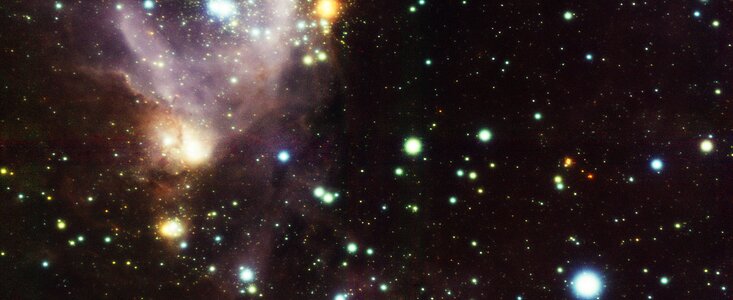Ultra-sharp Image Uncovers the Shocking Lives of Young Stars
17 June 2016
The world’s most advanced adaptive optics system reveals “shocking” details on star formation in a new image released today by the Gemini Observatory.
An unprecedented view from the Gemini South telescope in Chile probes a swarm of young and forming stars that appear to have been shocked into existence. The group, known as N159W, is located some 158,000 light years away in the Large Magellanic Cloud (LMC), a satellite to our Milky Way Galaxy. Despite the group’s distance beyond our galaxy the extreme resolution of the image presents researchers with a fresh perspective on how prior generations of stars can trigger, or shock, the formation of a new generation of stars.
“Because of the remarkable amount of detail, sensitivity, and depth in this image we identified about 100 new Young Stellar Objects, our YSOs, in this region,” says Benoit Neichel of the Laboratoire d’Astrophysique de Marseille, who worked with PhD student Anais Bernard on the research. Bernard expects to complete her PhD based upon this work in 2017.
Bernard adds that YSO’s are very red objects, often still enshrouded in a cocoon of the natal material from which they were born. “What we are seeing appears to be groups of YSOs forming at the edge of a bubble containing ionized gas expanding from an older generation of stars within the bubble.” Astronomers refer to these areas of expanding gas as HII regions due to the abundance of ionized (energized) hydrogen gas. “In a very real sense these young stars are being shocked into existence by the expanding gas from these more mature stars,” said Bernard.
“Without this advanced adaptive optics technology on Gemini we wouldn’t be able push our observations out to the distance of the LMC,” said Neichel. “This gives us a unique chance to explore star formation in a different environment.” He adds that part of the challenge is differentiating between “boring field stars” and the YSOs, which, he describes as “...the gems that make this research possible.”
The research team, led by Neichel and Bernard, published their work in the journal Astronomy and Astrophysics. The team used the Gemini South telescope with the Gemini Multi-conjugate adaptive optics System (GeMS) combined with the Gemini South Adaptive Optics Imager (GSAOI). The Gemini South adaptive optics system uses a multi-conjugated configuration that samples turbulence in several layers in our atmosphere using a “constellation” of five laser guide stars. This system provides exceptionally large adaptive optics fields of view and high levels of correction to minimize the blurring effect of atmospheric distortions uniformly across the image (essentially to the theoretical, or “diffraction limit”).
Contacts
Peter Michaud
Hilo, Hawai‘i
Tel: (808) 974-2510
Cell: 808-936-6644
Email: pmichaud@gemini.edu


